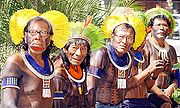
Kayapo people
Encyclopedia

Ge languages
The Jê languages , or Jê–Kaingang languages, are spoken by the Gê, a group of indigenous peoples in Brazil.-Family division:The language family is as follows:*Jaikó...
-speaking native peoples
Indigenous peoples in Brazil
The Indigenous peoples in Brazil comprise a large number of distinct ethnic groups who inhabited the country prior to the European invasion around 1500...
of the plain lands of the Mato Grosso
Mato Grosso
Mato Grosso is one of the states of Brazil, the third largest in area, located in the western part of the country.Neighboring states are Rondônia, Amazonas, Pará, Tocantins, Goiás and Mato Grosso do Sul. It also borders Bolivia to the southwest...
and Pará
Pará
Pará is a state in the north of Brazil. It borders the Brazilian states of Amapá, Maranhão, Tocantins, Mato Grosso, Amazonas and Roraima. To the northwest it also borders Guyana and Suriname, and to the northeast it borders the Atlantic Ocean. The capital is Belém.Pará is the most populous state...
in Brazil
Brazil
Brazil , officially the Federative Republic of Brazil , is the largest country in South America. It is the world's fifth largest country, both by geographical area and by population with over 192 million people...
, south of the Amazon Basin
Amazon Basin
The Amazon Basin is the part of South America drained by the Amazon River and its tributaries that drains an area of about , or roughly 40 percent of South America. The basin is located in the countries of Bolivia, Brazil, Colombia, Ecuador, Guyana, Peru, and Venezuela...
and along Rio Xingu
Xingu River
The Xingu River , also called Rio Xingu, is a 1,230-mile long, river in north Brazil; it is a southeast tributary of the Amazon River.-Description and history:...
and its tributaries.
In 2003, their population was 7,096.
Subgroups of the Kayapo include the Xikrin, Gorotire, Menkragnoti and Metyktire
Metyktire
The Metyktire is a native people who live on the Menkregnoti reservation in the Amazon basin. They are estimated to have about 87 members. They were discovered in May 2007 when two tribesmen entered a Kayapo-tribe village in the Menkregnoti reservation. The Metyktire form part of the Kayapo people...
.
Their villages typically consist of a dozen huts. A centrally located hut serves as a meeting place for village men to discuss community issues. They speak the Kayapo language
Kayapo language
Kayapó, also known as Mẽbengokre, is a Ge language of Brazil. The majority are monolingual, and most who are bilingual speak other indigenous languages; perhaps 1% speak Portuguese....
.
Land control and environmental issues
At one time, mining and logging threatened to destroy the rainforest, and thus their way of life. In retaliation, the Kayapo people used forceful tactics to banish loggers and miners in some areas, as well as to establish themselves as an economic force. Later, they were again threatened by secretive government plans to build a series of hydro-electric dams on their land. Under the leadership of Paulinho Paiakan, the Altamira GatheringAltamira Gathering
The Altamira Gathering was a five day media conference organized by the Kayapo people in an effort to raise awareness of the ecological and political atrocities committed by the Brazilian government....
was orchestrated by the Kayapo, drawing media attention worldwide. This demonstration, staged at the planned site for the first dam in Altamira, Pará
Altamira, Pará
Altamira is a city in the state of Pará, in northern Brazil. It is the largest municipality in the Americas by area, and the second in the world, after Jiuquan, China...
, lasted several days and brought much pressure upon both the World Bank
World Bank
The World Bank is an international financial institution that provides loans to developing countries for capital programmes.The World Bank's official goal is the reduction of poverty...
and the Brazilian government.
In addition, the rock star Sting made an appearance at the demonstration. After which, but not because of, the World Bank denied the request for a loan which was to be used to build the dam. The Brazilian government backed out of the plans, as well.
The forest gives them houses, transport, food and medicine. The problem is that rivers are essential to their way of life and gold mining in Brazil is polluting the rivers, therefore, spreading diseases throughout the tribes. The majority of their food is grown in forest gardens, which are created by using a method called slash and burn. The men of the tribe cut the trees down, and the women burn what's left. The main crop grown is a potato-like plant called manioc. It is deadly poisonous at first and has to be mulched up then have its juices squeezed out, after this it is safe to eat, but in addition to this they also cook it. They eat it at every meal.
Botany and agriculture
The Kayapo people use shifting cultivationShifting cultivation
Shifting cultivation is an agricultural system in which plots of land are cultivated temporarily, then abandoned. This system often involves clearing of a piece of land followed by several years of wood harvesting or farming, until the soil loses fertility...
, a type of farming where land is cultivated for a few years, after which the people move to a new area. New farmland is cleared and the old farm is allowed to lie fallow and replenish itself.
The Kayapo get medicine from 650 different plants that they find around their village.
They have trade agreements with The Body Shop
The Body Shop
The Body Shop International plc, known as The Body Shop, has 2,400 stores in 61 countries, and is the second largest cosmetic franchise in the world, following O Boticario, a Brazilian company...
.

